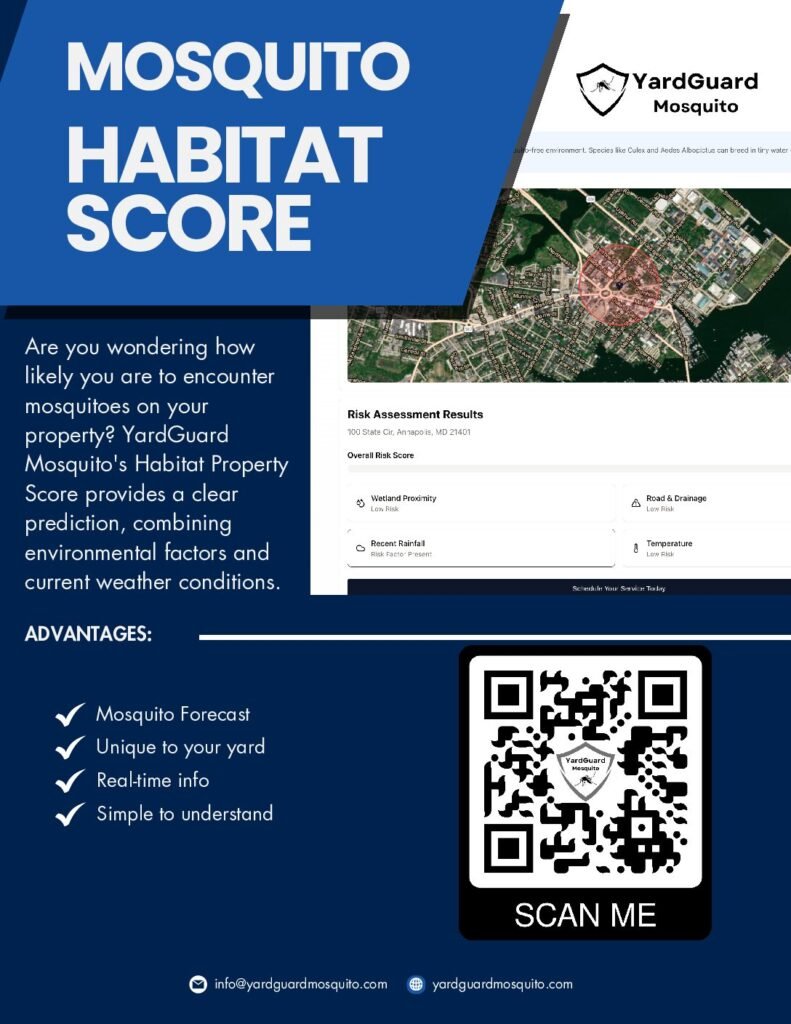Understanding Mosquito Risk: How does the tool work?
Imagine you want to know how likely you are to encounter mosquitoes in a particular area. YardGuard Mosquito’s Mosquito Magnet Score helps predict this by looking at two main things: the environment and the current weather. Think of it like figuring out the best places and times to find wildflowers – you’d consider the type of soil, sunlight, and recent rainfall. We do something similar for mosquitoes.

The Environment: Setting the Stage
First, we look at the surrounding environment. Some places are naturally more attractive to mosquitoes than others. For example:
- Wetlands and Marshes: These are like mosquito nurseries – lots of still water where they can lay their eggs.
- Roads and Ditches: Even these can be a problem. Rainwater can collect in ditches along roads, creating small pools perfect for mosquito breeding.
- Floodplains: Areas near rivers that sometimes flood are also important. When the water recedes, it leaves behind puddles that mosquitoes love.
We give each of these environmental features a “score” based on how much they contribute to mosquito risk. Wetlands, for instance, would get a higher score than roads.
The Weather: A Daily Check-Up
Next, we factor in the current weather. Mosquitoes, like most insects, are very sensitive to temperature and rain:
- Temperature: Mosquitoes are most active when it’s warm, but not too hot. Think of a “Goldilocks” zone – not too cold, not too hot, but just right. We have a way to measure how “just right” the temperature is for mosquitoes on any given day.
- Rainfall: Rain is a double-edged sword. Mosquitoes need water to breed, so some rain is good. But when it rained matters. If it rained recently, there are likely more puddles around for them to lay eggs. If it hasn’t rained in a while, those puddles might have dried up. We take this timing into account.
Putting It All Together: The Risk Score
Finally, we combine the environment scores and the weather scores. We add them up, giving more weight to the factors that matter most (like wetlands and recent rainfall). This gives us a final “risk score” between 0 and 1. A score of 0 means very low risk, and a score of 1 means very high risk. This score helps us understand how likely you are to encounter mosquitoes in a specific area, based on both the long-term environmental conditions and the day-to-day weather. It’s like a weather forecast, but for mosquitoes! This information can be useful for planning outdoor activities, or for helping you decide if YardGuard Mosquito’s Services are right for your home.
Resources
The Effect of Weather Variables on Mosquito Activity: A Snapshot of the …A Systematic Review of the Effects of Temperature on Anopheles Mosquito …Temperature dependence of mosquitoes: Comparing mechanistic and machine …Effects of climatic and environmental factors on mosquito population …Impact of meteorological parameters on mosquito population abundance …A stage structured mosquito model incorporating effects of …Role of Climate and Environmental Changes in Mosquito Population …Effect of climate change on mosquito population and changing pattern of …Eutrophication and predator presence overrule the effects of …Habitat and microclimate affect the resting site selection of mosquitoes
